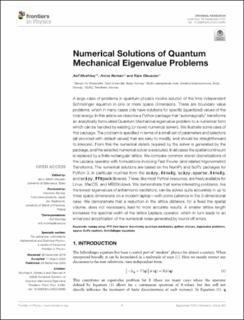Numerical Solutions of Quantum Mechanical Eigenvalue Problems
Peer reviewed, Journal article
Published version
Permanent lenke
https://hdl.handle.net/11250/2728676Utgivelsesdato
2020Metadata
Vis full innførselSamlinger
Originalversjon
Mushtaq, A., Noreen, A. & Olaussen, K. (2020). Numerical Solutions of Quantum Mechanical Eigenvalue Problems. Frontiers in Physics, 8: 390. doi: 10.3389/fphy.2020.00390Sammendrag
A large class of problems in quantum physics involve solution of the time independent Schrödinger equation in one or more space dimensions. These are boundary value problems, which in many cases only have solutions for specific (quantized) values of the total energy. In this article we describe a Python package that “automagically” transforms an analytically formulated Quantum Mechanical eigenvalue problem to a numerical form which can be handled by existing (or novel) numerical solvers. We illustrate some uses of this package. The problem is specified in terms of a small set of parameters and selectors (all provided with default values) that are easy to modify, and should be straightforward to interpret. From this the numerical details required by the solver is generated by the package, and the selected numerical solver is executed. In all cases the spatial continuum is replaced by a finite rectangular lattice. We compare common stensil discretizations of the Laplace operator with formulations involving Fast Fourier (and related trigonometric) Transforms. The numerical solutions are based on the NumPy and SciPy packages for Python 3, in particular routines from the scipy.linalg, scipy.sparse.linalg, and scipy.fftpack libraries. These, like most Python resources, are freely available for Linux, MacOS, and MSWindows. We demonstrate that some interesting problems, like the lowest eigenvalues of anharmonic oscillators, can be solved quite accurately in up to three space dimensions on a modern laptop—with some patience in the 3-dimensional case. We demonstrate that a reduction in the lattice distance, for a fixed the spatial volume, does not necessarily lead to more accurate results: A smaller lattice length increases the spectral width of the lattice Laplace operator, which in turn leads to an enhanced amplification of the numerical noise generated by round-off errors.

